Hydraulic accumulator, hydraulic tank or membrane tank - necessary element for a closed, autonomous water supply system in any private home. These devices are intended for:
1.Accumulating water and ensuring the required and constant pressure in the water supply system;
2. Reducing the frequency of pump activation, which helps to increase the pump life;
3.Preventing the system from water hammer when the pump suddenly turns off or on;
4. Maintaining a reserve amount of water in case of a power outage. In hot water supply systems, hydraulic accumulators are used to compensate for temperature expansion.
Design and principle of operationhydraulic accumulator
Hydraulic accumulator is a sealed, metal container, inside of which there iselastic membrane , which divides the container into two parts. One part contains a pressurized inert gas orair, and in the other - water. The water isin the water chamber-membrane anddoes not come into contact with the metal body. The membrane is made of durable EPDM rubber material that meets all hygienic and sanitary standards drinking water. The air chamber contains a pneumatic valve (spool), regulating air pressure.
Water is supplied to the water supply system and hydraulic accumulator using a pump. As a result, the pressure V water supply network
increases. When it reaches certain, pre-established values, system automatic control turns off the pump and the water supply stops. With little volume water intake, the hydraulic accumulator will release this volume, the pressure in the system will drop, but the pressure switch will not turn on the pump. When drawing more water and achieving lower pressure mark , set on the relay,the pump turns on and starts pumping water to compensate for its consumption.
Hydraulic accumulators can be vertical or horizontal configurations. Hydraulic accumulators for water supply and expansion tanks for hot water supply systems designed for temperature up to 80 degrees C and pressure up to 12 Atm.
Selecting a hydraulic accumulator
What type of accumulator should I choose?
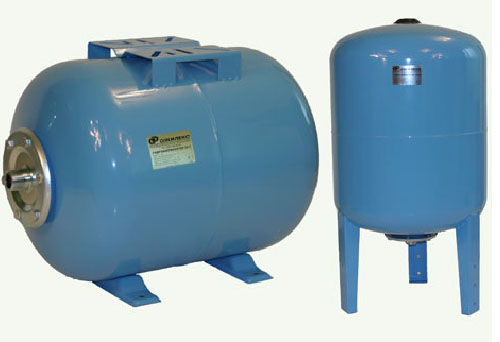
Depending on the shape of the body, this equipment is divided into two types - hydraulic accumulator horizontal And vertical. The choice of tank shape is made based on the size of the room where it will be installed, guided primarily by the availability of free space in the room. If the free space allows you to install any of the modifications, and the volume of the hydraulic accumulator exceeds 100 liters, it would be more advisable to purchase a vertical model. The fact is that in water supply systems there is always dissolved air in the water. Over time, as the system operates, this air is released from the water and accumulates in various places, forming air pockets.One of these places is the top of the accumulator inside a rubber membrane.
In a vertical accumulator, the area of the upper part is smaller, which facilitates the process of bleeding air. This is usually done using a specialair release valve.
In hydraulic accumulators horizontal type Air removal can be done using an additional section of pipeline with a valve.
In hydraulic accumulators of small volumes, the air accumulated in them is removed by periodically turning off the power supply to the pump and bleeding the accumulated air through the water collection point closest to the hydraulic accumulator.
How to choose the volume of a water supply accumulator?
Correctly selected volume hydraulic accumulatorfor water supply systems, maybe provide not only stability of pressure in an individual pipeline, but also extend the service life of the pump and communications.
Exists a large number of initial data that must be taken into account:
1.The amount of equipment that requires water to operate;
2.Number of people using water;
3. The number of permissible pump starts/stops per hour.
4.P pump performance
The nominal volume is selected taking into account the fact that the accumulator during normal operation is turned on about 15 times per hour. In this case, the basic parameter in the calculations is the volume of water consumption.
Below are several ways to calculate the volume of a hydraulic accumulator:
1.Depending on the type of installation and pump power.
Surface pumps:
power up to 1 kW -
horizontal model 24 l .
power more than 1 kW -
horizontal model 50 l.
Submersible pumps:
power up to 500 W - horizontal or vertical 24 l model.
power up to 1 kW -
horizontal or vertical model for 50 l.
power up to 1.5 kW -
horizontal or vertical model 100 l.
2. By the number of water points.
Up to 3 water distribution points, pump with a capacity of about 2 cubic meters. m./hour - hydraulic accumulator up to 24 l.
- up to 8 points water collection, pump with a capacity of about 3.5 cubic meters. m./hour - hydraulic accumulator 50 l.
- more than 10 points water collection, pump with a capacity of about 5 cubic meters. m./hour - hydraulic accumulator 100 l.
3. By performance parameter
The calculation is performed using the formula:
O = K*Rmax*(Dmax + 1)*(Dmin+1)/(Dmax-Dmin) - (P + 1)
Where:
K
- pump power factor;
- power 0.55-1.5 kW - 0.2;
- power 2-3 kW - 0.375;
- power 4-5.5 kW - 0.625;
- power 5-9 kW - 0.875.
Rmax
- the highest planned flow rate of liters of water per minute;
Dmax
- water pressure level in the tank to turn off the pump (Bar);
Dmin
- water pressure limit for turning on the pump (Bar);
R
- air pressure in the hydraulic tank (Bar).
4. Calculation method UNI 9182
This method is a more accurate algorithm for calculating the volume of the hydraulic accumulator and designed for premises equipped with equipment that consumes a significant amount of water.
Calculation methodUNI 9182
consists of several points:
1. Determination of the total coefficient of water consumption Su.
|
Type of equipment |
Utilization factor Cx |
Number of each type n |
Product Cx x n |
|
Toilet |
|||
|
Shower |
|||
|
Bathroom |
|||
|
Faucet in the sink |
|||
|
Bidet |
|||
|
Faucet in the kitchen |
|||
|
Washing machine |
|||
|
Dishwashing machine |
|||
|
Irrigation tap |
|||
|
The total coefficient Su is = _______ |
|||
2. Determination of the value of the maximum water flow Qmax.
Maximum water flow values Qmax, depending on the obtained value of the total coefficient Su are presented in the table.
3. Determination of the volume of the hydraulic accumulator.
To determine the volume of the accumulator, it is necessary to determine how many times per hour ( A) it is allowed to turn on the hydraulic accumulator at maximum consumption intensity. 10-15 times per hour is considered normal. It is also required to assign thresholds pressure at which it turns on(Pmin) and turns off(Pmax) pump.
Then, to determine the volume of the accumulator, you must use the following formula:
![]()
Where:
V- total volume of the hydraulic accumulator (liter),
Qmax- maximum value of required water flow (liter/min),
A- number of system starts per hour,
Pmin- lower pressure threshold when turning on the pump (bar),
Pmax- upper pressure threshold when turning off the pump (bar),
Po- initial gas pressure in the accumulator (bar).
Calculation of air pressure in the accumulator
The air pressure in the hydraulic accumulator must be greater than or equal to the hydrostatic pressure. For determining hydrostatic pressure, it is necessary to determine height distance between the top disassembly point and the location point of the hydraulic accumulator. Also for sustainable system operation, pressure difference between the upper point of disassembly and the location point of the hydraulic accumulator must be at least 0.5 bar.Thus, the minimum value of air pressure in the accumulator Po equals 0.5 bar plus the value of the reduced hydrostatic pressure at the location of the accumulator.
For example:
If the difference between the upper point of analysis and the location of the hydraulic accumulator is 7m (1m=0.1 bar), we get Po=0.7 bar+ 0.5 bar=1.2 bar (atm)
Expansion tank, expansion tank, hydraulic accumulator - these are one and the same thing!!!
This article will help you choose, buy, and then install the hydraulic accumulator with your own hands. Let's consider all the nuances with hydraulic accumulators.
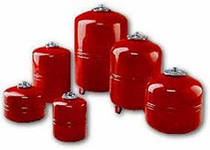
In this article you will learn:
Hydraulic accumulator
This is a special element of water supply and heating systems that serves to take on the volume of liquid, thereby taking away overpressure. And return the fluid to maintain pressure. There are actually three goals, but they overlap with each other.
The first goal is the ability to accumulate (accumulate) a volume of liquid.
The second goal is to accumulate liquid and remove excess pressure.
The third goal - few people know about this - is to dampen water hammer in the water supply and heating systems. That is why even the smallest hydraulic accumulators have such a large thread of one inch (1).
To understand the following malfunction you need to see the diagram automatic water supply private house. 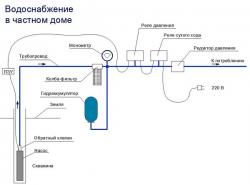
This scheme is discussed in this article: Training course. Automatic water supply with your own hands.
How to determine malfunctions of hydraulic accumulators in the automatic water supply system of a private house:
1.
The water began to flow in small portions. That is, there is repeated periodic spitting out of water from the tap in small portions.
2.
The pressure gauge needle jumps sharply up and drops to zero.
then first check the following: While observing the pressure gauge, press the accumulator spool, releasing air. If the needle on the pressure gauge goes down sharply, it means there is very little air. Hold the spool and release all the air completely. If water comes out, then the membrane is torn. If not, then the membrane is intact and the air has escaped through the cracks or spool. What to do next will be described below.
How to determine malfunctions of hydraulic accumulators in hot water supply:
1.
From safety valve, which is installed near the water heater, began to dig in.
If these symptoms are present,
How to determine malfunctions of hydraulic accumulators in a heating system:
1.
The pressure in the system has become unstable, the pressure rises and falls sharply. Unfortunately, I won’t tell you how much it rises and falls - it depends on many factors. Only experience will tell you. From experience I can say that a well-tuned system should have an amplitude of no more than 0.6 bar. Less is better. This is, for example, from 1.4-2 bar. If you have more, you should be wary and check the operation of your accumulator. Perhaps the volume is not enough.
If this symptom is present, then first check the following: Press the spool button and release the air for a split second. If there is no air, then the air has somehow escaped through the cracks or the spool. If water pours out, it means the membrane is torn. If there is no water, release the air completely. If there is no air and no water comes out, then the membrane is intact. What to do next will be described below.
There is an opinion among the people that air gradually leaves the accumulator, even if everything there is sealed. This is possible due to some capillary reactions. Air can leak: Even through metal and even rubber (I read it from chemistry, and many people talked about it). But in my experience, the service life of a hydraulic accumulator can easily reach three years. There have been cases from my practice: It’s already been 4 years since I installed a hydraulic accumulator for my father’s water supply, but he doesn’t give a damn. Works great.
In cases where air has escaped- you should tighten the nut on the spool pin. And buy a metal car cap with a rubber gasket, which is sold in auto stores. And after pumping in air, screw the cap onto the pipe, which will prevent air from escaping from the spool. What to download and how much to download will be described below.
There is a rubber membrane inside the accumulator - this membrane looks something like this: 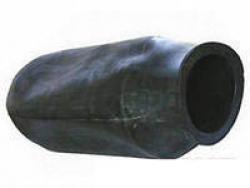
The membrane follows the shape of the accumulator itself, which we see from the outside. Outside the membrane is the normal air we breathe. And water is poured inside the membrane. 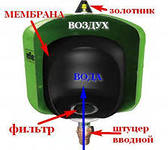
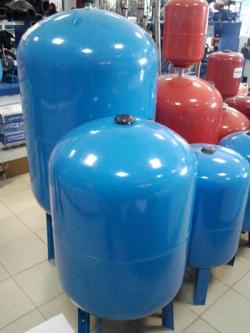
Some large volume hydraulic accumulators have the following membrane: 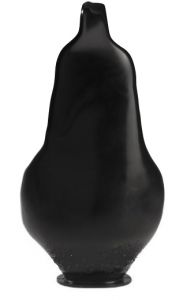
The water enters the membrane from below, and the other outlet is designed to release air from the water or coolant. Thus, large hydraulic accumulators are equipped with two threaded connections (1/2-1): The lower one is for supplying liquid (water or coolant), the upper one is for venting air. Do not confuse the pipe with the spool from the thread for releasing air. In this case, the spool pin is located on the bottom side. Typically, an automatic air vent is screwed onto the top thread to release air automatically. But cases cannot be ruled out when the liquid supply is connected to the top, if the bore diameter allows. When feeding occurs from above, the air vent can be neglected. In this case, accumulations of small crumbs and sand are possible if there is no filter.
Hydraulic accumulator in a simple way, people call them names expansion tank. Therefore, the hydraulic accumulator and expansion tank are synonymous, since by virtue of their life they perform one task.
There are blue and red hydraulic accumulators! So it was agreed that Blue colour relate to water supply and cold water. And red color refers to heating and hot water. There are also colorless hydraulic accumulators on the market.
There is one more nuance: In blue accumulators food grade rubber is used, and manufacturers try to use safe rubber for human health in blue accumulators. It is also possible to change the membrane in blue accumulators. But not always in red.
It is a big misconception to believe that a red hydraulic accumulator withstands large temperature overloads (that is, withstand high temperatures). In our case, we can configure the system so that hot water the hydraulic accumulator will not always reach. Setting up the system will be described below.
Changing the membrane in a hydraulic accumulator is not at all troublesome. So if the membrane breaks, it is still cheaper to buy the rubber membrane itself than to buy a hydraulic accumulator. To change the membrane, you need very simple operations: Unscrew all the bolts, pull out the old membrane and install a new membrane. This is done once or twice. All bolts must be tightened evenly. Do not tighten only one bolt to the end, as the edge of the membrane may move and go inward, which will lead to leaks. Do not apply sealant to the joints, since sealant reduces friction between metal and rubber and when tightened, the membrane will roll (slide) inward and form a loose connection and leaks will also occur.
Blue accumulators, They are almost always used for water supply and therefore have an increased operating pressure threshold of up to 8 Bar. And the red ones have up to 5 Bar.
Where is a hydraulic accumulator used? Purpose of the hydraulic accumulator.
If we define it through the eyes of a physicist, then a hydraulic accumulator is used where necessary:
1. Create the ability to accumulate a liquid medium in the form of an occupied additional volume in space. A space that changes depending on the deformation of the air in the accumulator.
2. Create the ability to reduce or balance surges in hydrostatic pressure. That is, reduce the influence of excess or decrease in pressure in confined space.
Its value as an element water supply and heating systems - accept a liquid medium due to an increase in pressure and release it due to a decrease.
Hence its purpose- Getting rid of pressure surges by releasing or increasing the volume of fluid in a confined space.
Its purpose still depends on the task being performed, which we will consider further.
Where to use a hydraulic accumulator?(From simple to complex).
1.
In the water supply system.
2.
In the heating system.
Parameters of hydraulic accumulators.
Each hydraulic accumulator is equipped with two main parameters:
1. Working maximum pressure. On average, for water supply 6-8 atmospheres (bar). For heating 5 Bar.
2. Volume of the hydraulic accumulator. The hydraulic accumulator itself, which we see from the outside, is this external shape in volume and is indicated in the passport or on the label. The liquid that the accumulator can accept is significantly lower, maybe even half, depending on the pressure amplitude (the difference between the upper and lower pressure limits). The higher the difference, the more the battery can accept.
Each hydraulic accumulator must be checked for the permissible value of inflated air pressure. The hydraulic accumulator has a valve spool like a car wheel. To check and set the required air pressure value, you will need a regular car pump, which is used to inflate car wheel. Preferably with a pressure gauge that shows the pressure inside the tire. Car pump pressure gauges have a Pascal scale (Pa, MPa). That is, on a pressure gauge, a scale of 0.1 MPa will be equal to one atmosphere (1 Bar).
We’ll talk about how much air should be pumped in below.
Hydraulic accumulator in the water supply system.
If something is not clear about automatic water supply for a private house, then please read here: Training course. Automatic water supply with your own hands.
The hydraulic accumulator in the water supply system serves to accumulate water. To maintain constant pressure in the pipeline. In rare cases, on long sections of pipeline to protect against water hammer.
Also, the blue accumulator must be installed for hot water supply. Where the water heats up, the water always expands. And when the water expands, it begins to increase pressure, which leads to the release of water from the safety valve. To prevent a strong increase in pressure, a hydraulic accumulator is installed.
Setting up a hydraulic accumulator for an automatic water supply system.
U automatic system water supply of a private house, where there is a pressure switch, which is set to certain thresholds of maximum and minimum pressure. In this case, the accumulator needs a pressure lower than the minimum lower pressure threshold by 2-3 meters (0.2-0.3 Bar). The minimum pressure of the relay can be determined by observing the change in the needle on the pressure gauge. That is, if the minimum pressure is 1.5 Bar, then the air pressure should be 1.2 Bar.
Setting procedure:
1. If your accumulator is already connected to an automatic water supply system and there is water in it, then you need to turn off the power to the system. Next, drain the tap to remove all the water in the system. Leave the tap open. A situation may arise when there is water in your accumulator. And start pumping air through a car or other pump. During the pumping process, if water starts flowing from the tap, this means that there is water in the accumulator. This symptom indicates the following: Or air depressurization has occurred, and air has escaped through some cracks or through the spool; Or the membrane has broken. And if any symptom occurs, then you need to stop pumping air. Next, close the tap and turn on the water supply system. Open the tap and let 20 liters of water flow through. Close the tap. Next, go to the accumulator and press the spool until the air runs out. If water flows through the spool, this means that the membrane has broken. The membrane needs to be changed.
If there is no water, then everything is fine with the membrane. It is necessary to repeat the pumping process to the desired pressure, which was described above.
After you have established the required air pressure in the accumulator, turn on the power and open the tap and release the water. Go to the pressure gauge and watch the needle. The first time it drops to zero is not scary - it means that there was some air in the accumulator and it came out. But the second time, when the arrow drops to zero, this means that the air pressure is greater than the minimum pressure of the relay. It is necessary to gradually bleed air from the accumulator and check again. If possible, watch the water coming out of the tap. Water from the tap should flow continuously.
There is a more professional way how to set the pressure in the accumulator.
Pump air into the accumulator, slightly more than the minimum pressure threshold of the relay. Next connect to the water supply system. Close the taps in the bathrooms and turn on the power. Let the accumulator fill up a little. Turn off the power to the pump. And drain all the water from the hydraulic accumulator from the tap - this will make it possible to get rid of unnecessary air in the system, which spoils the setting. Restart the pump power to a pressure just above the minimum pressure threshold of the relay. Next, turn off the power to the pump. And smoothly release the pressure through the tap to the required mark on the pressure gauge. And if the arrow is at the required value below the minimum threshold of the relay, then air is released from the accumulator and as soon as the pressure on the pressure gauge drops, then stop bleeding air from the accumulator. Since the arrow drops at the moment when the air pressure becomes less than the system pressure and at this moment water begins to flow into the accumulator. And the setup is complete. Next, turn on the power and open the tap to release water, and watch the lower pressure threshold and if the arrow on the pressure gauge does not fall to zero, then everything is fine. If the needle on the pressure gauge drops sharply to zero, it means you need to bleed a little more air.
Selecting the volume of a hydraulic accumulator for an automatic system Water supply to a private home is a very controversial issue. I can recommend it purely economically - it's 80 liters. Not too much, not too little, and not expensive. Possibility of finding a membrane for such a hydraulic accumulator. Doesn't take up much space.
For those who want to know how to assemble an automatic water supply with their own hands, go here: Training course. Automatic water supply with your own hands.
Setting up a hydraulic accumulator for hot water supply.
Information on how to connect electric water heater in the apartment.
Blue accumulators can be used for hot water supply. In addition, their operating pressure threshold is higher than that of red hydraulic accumulators.
First, let's look at the diagrams where the accumulator is installed.
Scheme 1.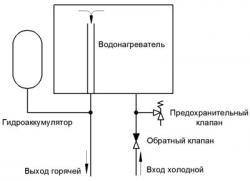
Scheme 2.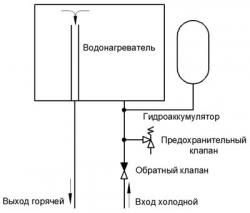
Scheme 1 helps to save materials for connecting the hydraulic accumulator, and also helps make assembly simpler and more efficient. The difference between scheme 1 and scheme 2 is not significant. It is better to choose scheme 2, since cooler water will flow into the accumulator.
Regarding volume, then the volume for hot water supply is 5-10% of the volume of heated water. That is, if the volume of heated water is 300 liters, then the volume of the hydraulic accumulator according to the passport will be 15-30 liters. It's a matter of taste, the more the better. If these are large volumes of heated water 300-500 liters, then 5% will do. If small, up to 100 liters, then 10% of the volume of heated water. For central water supply, it is better to use larger volumes of hydraulic accumulators. Since the pressure there is very unstable and you can get under required pressure very difficult. There is a large pressure difference.
Air pressure in the accumulator for hot water supply. This is also a complex question; there are currently two directions in which to navigate:
1. Average value between the minimum water supply pressure and the safety valve relief pressure. This is actually conditionally acceptable. More is less, and the accumulator will still work, perhaps even for a long time. Typically the safety valve has 6 bar. Minimum pressure in central water supply about 2 bar. And the average is 4 bar.
2. Accurate pressure calculation. An accurate calculation helps to understand such factors as: membrane service life, obtaining maximum efficiency of the accumulator.
To obtain a calculation, you need to identify the problem or factors influencing these calculations.
The first factor: is to obtain maximum efficiency (Coefficient useful action).
Second factor: Receipt long term hydraulic accumulator service.
Obtaining maximum efficiency is expressed by obtaining maximum water accumulation in the accumulator. That is, to obtain parameters that are capable of accepting as much water as possible during expansion.
The most basic problem with the failure or functioning of a hydraulic accumulator is the depressurization of two different media (Water and Air). When the rubber membrane breaks, depressurization occurs. It is also possible that air escapes from the accumulator, thereby reducing the pressure in the accumulator, which leads to incorrect operating parameters of the accumulator. Often the spool starts to release air, and to eliminate the influence of the spool, you need to tighten a metal cap with a rubber gasket, which is sold in car dealerships. This cap prevents air from escaping through a faulty spool. You can also try to tighten the pipe nut. See image. 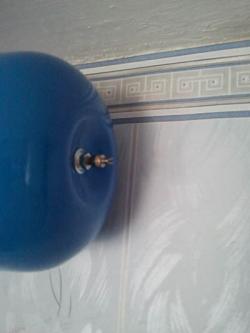
What causes the rubber membrane to break? The membrane breaks due to simple wear and tear of the rubber through constant expansion, contraction and bending of the rubber. But there is one reason that greatly increases the wear of the rubber membrane, but more on that later...
There is an opinion that when there is not enough air in the accumulator, the membrane expands greatly, thereby greatly stretching the rubber, ultimately leading to rupture of the membrane. Seeing what kind of membranes are in the accumulator, one is led to the idea that this cannot be, since the membranes themselves are large enough to expand to fill or repeat the entire outer volume of the accumulator without causing severe stretch marks. That is, they don’t really stretch there in order to tear themselves by stretching.
The main reason for rapid tire wear is at least, it seems so to me, you may think differently, but I will put it this way: This is when there is a rapid release of water from the hydraulic accumulator. That is, water quickly leaves the accumulator as a result of a decrease or lack of pressure in the water supply system. When you open the tap all the way, the pressure in the water supply system decreases and the accumulator begins to release water, and as soon as the water in the membrane runs out, the membrane sharply collapses into a flat sheet. The edges of the so-called sheet bend strongly. And what more difference pressure between air and water, the more destructive it is for the rubber membrane. In other words, reverse water hammer occurs. Constant such sharp or even slow folding of the membrane is very detrimental to rubber.
Of course, I don’t argue with you; you can trust specialists who think differently. But how can you put it? Many, many people and specialists are still uploading high pressure into the hydraulic accumulator, motivating this by not greatly expanding the membrane. Or even believing that the membrane should not expand at all, only in rare cases. That is, some experts, when pumping up a hydraulic accumulator strongly, assume that there should be no expansion at all, and if expansion suddenly occurs, it will be a very rare occurrence. Thus, as if mistakenly believing that the rubber will remain at constant rest for a long time (in the form of a rolled sheet), thereby increasing its service life. Are they wrong?
The water in the accumulator constantly expands when heated, and will constantly disturb the accumulator.
Therefore, it is not advisable to have a membrane in the accumulator that turns into a rolled sheet. This is detrimental to the membrane.
And so, the proof listed above gives one identity: the membrane should not, from time to time, roll up into a sheet. To prevent the membrane from folding into a sheet, the air pressure in the accumulator must be less than the water pressure. It’s as if the membrane in the accumulator must be constantly filled.
And in order to obtain maximum efficiency of a hydraulic accumulator, it is necessary that in quiet mode there is as little water in the accumulator as possible.
The exact calculation will be for an apartment: Pump the accumulator with air to a pressure less than the minimum water pressure. That is, you need to find out, either by experience or by numbers from specialists, what the pressure is in your home, or better yet, find out what the minimum pressure is in your apartment. But consider one more fact! When you open a tap in the kitchen or bathroom, the pressure drops - that's a fact! Therefore, subtract one more atmosphere from the minimum pressure and get the pressure that must be given to the air in the accumulator. The pressure will be 1 Bar less than the minimum water pressure.
You can also check central water pressure on your own! There are some ways to check:
1.
Pump the accumulator with air to one atmosphere. Connect it to water. And after a moment, the air pressure in the accumulator will be equal to the water pressure. And connect the pump to the accumulator and it will show you the pressure. After you have found out the pressure, you need to turn off the water supply taps and reduce the hot water supply pressure to zero. And start pumping the required pressure.
2.
The second method is suitable only if there is a tap between the accumulator and the water supply system. Pump up the hydraulic accumulator to 4 atmospheres, connect it to water. Open the tap - if water begins to flow into the accumulator (Listen and you will hear), it means that the water pressure is above 4 atmospheres. If not, then close the tap. Bleed the air from the accumulator to 3 atmospheres. Open the tap - and if the water gurgles (the sound of flowing water in a pipe). The water should flow for at least 3-5 seconds. Just don’t confuse this murmur with filling the pipe leading to the hydraulic accumulator. The second method requires a lot of experience or technical engineering thinking. It makes it possible to immediately set the accumulator pressure by bleeding air from the accumulator, without resorting to additional pumping.
Accurate calculation for a private house: Pump the accumulator with air to a pressure less than the minimum water pressure, 1 bar. That is, if your minimum pressure on the pressure gauge shows 1.5 Bar, then the air pressure in the accumulator should be 0.5 Bar.
Setting up a hydraulic accumulator for water heating.
Firstly, when pumping air into the accumulator, you need to disconnect it from the heating system. There needs to be no water in it.
We will not consider the diagram here, since any water system The heating system has an expansion tank or a hydraulic accumulator. The hydraulic accumulator is connected to the central main return pipeline. Closer to the boiler or boiler room. But this does not mean that if you install it in another place it will not work.
The main task of a hydraulic accumulator in a water heating system- this is to suppress pressure surges when the coolant temperature changes. This task does not require large flow rates into the coolant hydraulic accumulator. It is enough to even connect the hydraulic accumulator with an ordinary flexible hose, which we connect to the toilet tank. But in some cases it is necessary to increase the diameter of the supply pipe to the accumulator: In cases of dirty, rusty water, in order to prevent clogging and sand accumulation in the pipe (20mm). And in cases where it is necessary to additionally protect the pipeline from hydraulic shocks. In this case, the diameter of the pipeline must be repeated main pipeline and should be connected as close as possible to main pipe.
In my experience, there have been cases when hoses turned out to be not a reliable conductor of coolant, since the material from which they were made was simply corroded by corrosion and the connection simply broke and cracked.
The size or volume of a hydraulic accumulator for heating systems.
To heat a private house, use a red hydraulic accumulator, especially for heating. Since it uses more technical rubber and can last longer. Blue hydraulic accumulators use food grade rubber and for this purpose manufacturers may sacrifice the quality of the rubber for the health of citizens.
I heard somewhere, and some sellers said, that if you take a deliberately large size accumulator, it will be worse than with a small volume accumulator.
The basic rule is that the larger the volume of the accumulator, the better. With a large volume, pressure surges are less noticeable than with a small volume of the accumulator.
But there is already an ingrained rule, and it justifies the economic factor. This is 10% of the total volume of coolant (water).
How to calculate the volume of coolant for your home?
Multiply the number of sections of the most common radiator by 0.3 liters and add 10-20% of the supply pipeline to the answer received, depending on the circuit. If there are heated floors, then add 0.2 liters for each square of heated floors. (This is a simplified version of the calculation. The accuracy is conditional, statistical).
Setting up a hydraulic accumulator for heating.
To calculate what pressure should be pumped into the accumulator you need to know:
1. The height of the highest point of the heating system or radiator from the horizon itself expansion tank. For a three-story house with a basement, let’s assume 9 meters.
2. Minimum threshold for shutting down your boiler. If you have complex electric heating equipment (boiler), then perhaps it has a boiler shutdown threshold at minimum pressure. This protection is designed to prevent the boiler from operating without water. And if the pressure is low, then there may be no water. This threshold is usually 0.5 Bar.
Option 1. Do you have an ancient boiler or operates at any pressure. In this case, the pressure of the pumped air in the hydraulic accumulator must be equal to the height (From the hydraulic accumulator to the upper radiator). If we have 9 meters, then translated into Bar it will be 0.9 bar or 0.09 MPa. But keep in mind that the average pressure in the heating system will definitely be higher. Next you need cold water set the pressure about 3-4 meters more than 0.9 Bar - this is equal to 1.3 bar. And leave it at this pressure.
Turn on the heating and warm up the system to 60 degrees and remember the pressure that was obtained at 60 degrees. And if at this temperature the pressure becomes less, then add coolant to the required value that you remember. If you do not add pressure, then when the coolant cools, a situation will arise when the pressure drops sharply after 0.9 bar. Since at this pressure there is no coolant in the accumulator and the water will decrease sharply. Thus, the required pressure may not be available in the upper radiators.
To prove this calculation, I’ll tell you this:
Why do you need to pump in 9 meters of air pressure? The fact is that if the pressure in the system is less than 9 meters, then our water simply will not rise to the upper radiators and will not fill them. Therefore, the pressure in the system must always be greater than 9 meters (0.9 bar). And the hydraulic accumulator, when inflated to its maximum in its original position, has less coolant inside it. And therefore, an inflated hydraulic accumulator with such parameters will accept more coolant during expansion. As a result, we can safely say that we use our hydraulic accumulator with maximum efficiency. That is, with maximum capabilities.
By the way, for those who don’t know, I’ll explain: 1 bar of pressure raises a column of water 10 meters in height.
Option 2. Cottage with a basement (height 3 meters). But our boiler turns off at a pressure less than 0.5 bar. In this case, we may not take into account the height of the upper radiators. And feel free to pump air into the accumulator to a pressure of slightly less than 0.5 bar. Let's pump up 0.4 Bar. In this case, you can safely set the pressure cold water in the system up to 1 bar. And don't add any more. Then do not forget to note what pressure will be when the water is heated to 60 degrees. If it exceeds 1.5 bar, then it is better to reduce it for one floor. In general, I recommend using low pressure whenever possible, but within limits so that the pressure does not drop significantly when the coolant cools down.
To prove the second option, I’ll tell you this:
Very often I have encountered, and I am not the only one, the phenomenon that you come as a lady and discover that the boiler is not working. There are a lot of reasons, maybe there are leaks somewhere. Or maybe the electricity was turned off and all the water in the system cooled down and this, NOTE, reduced the pressure in the system and the pressure went beyond the threshold for turning on the boiler. But after the electricity was given, the boiler did not turn on and did not work! Therefore, you need to take into account a gradual decrease in pressure to 0.4 bar. So that during a power outage, the pressure does not reach critical pressure.
Option 3. Three-story house with a basement (Height 9 meters) and a boiler with a shutdown threshold of 0.5 bar. In this case, we can use the first option described above. Since when the water rises to 9 meters, the boiler will have a pressure of 0.9 bar. Even if there are big leaks. The difference between 0.5 and 0.9 bar is 0.4 bar - that’s 4 meters. Just imagine how much water must pour out, it’s 4 meters, that’s almost the entire floor with all the radiators (30 liters). And only after that the pressure at the boiler will drop to critical and the boiler will turn off. For the third option, pump the accumulator with air to 0.9 bar. Set the pressure in the cold water system to 1.3 bar. The pressure in the system will increase as the water heats up. Remember the pressure when the coolant is heated, so that when the coolant is heated, the pressure is set correctly.
If you leave home for several days, it is better to have high blood pressure. Since over time the pressure drops due to the release of gases. In the future, you will understand how much you need to add in order to check the heating once a month. You can increase the pressure to 2.5 bar with a well-heated coolant. If you often have to add pressure, then you should think about whether everything is okay with your accumulator. If everything is in order with the hydraulic accumulator, then you should think about increasing the volume of the hydraulic accumulator. If you increase the volume of the hydraulic accumulator in the heating system, you can add another hydraulic accumulator and there will already be two of them. This makes it possible to save on the purchase of a hydraulic accumulator.
Option 4. If this is a one-story building and the boiler does not have shutdown thresholds. Then in this case you can generally pump up the hydraulic accumulator to 0.1 bar, and pump cold water into the system to 0.4 bar.
By the way, keep in mind that new advanced boilers have built-in hydraulic accumulators.
Regarding professional tuning of the hydraulic accumulator for heating. Then it is necessary to pump in obviously high air pressure from the beginning. Connect it to the heating system. Set the heating system to the required value to which the hydraulic accumulator should be adjusted. Once set, bleed air from the spool and observe the pressure gauge in the heating system. As soon as the pressure gauge needle deviates (the value has decreased), we stop venting air. Screw the cap on and you're done.
Hydraulic accumulators
General information
A hydraulic accumulator is a water tank with an elastic membrane, in one part of which there is water, in the other there is compressed air. Designed to store a certain amount of water under pressure. It is the hydraulic accumulator that provides pressure in the water supply system when the pump is turned off. The hydraulic accumulator consists of:
- Housings
- Rubber membrane
- Flange
- Nipple for pumping and bleeding air into cavity B (6)
- Bleed nipple cavity A (7)
The principle of operation of the hydraulic accumulator is very simple. Initially, dry air is pumped into cavity B of the accumulator, usually at a pressure of 1.5 atm. Water from the main through threaded connection enters cavity A, filling it. The air in cavity B is compressed and the pressure increases. Thus, in working condition, the hydraulic accumulator always contains both air and water, which are separated from each other by a diaphragm made of food-grade rubber. Over time, the air pressure in cavity B may decrease. During normal operation, once a year it is necessary to check the air pressure in the accumulator in the absence of water in cavity A. If the pressure is less than normal, then it can be pumped up using a conventional automobile pump through a nipple.
It should be noted that the accumulator is never completely filled with water. The actual volume of water in it depends on many parameters. For example, on the initial air pressure in the accumulator, the upper and lower set thresholds of the pressure switch in the system, the elasticity and geometric shape of the diaphragm, the shape of the accumulator. To obtain the volume of water supplied by the accumulator, you can use the following formula:
Vga = Vo x α x β
Where
Vga - volume of water supplied by the hydraulic accumulator, liter
Vo - total overall volume of the hydraulic accumulator, liter
α - coefficient of initial data
β is the reduced elasticity coefficient of the membrane.
The given membrane elasticity coefficient b depends on its shape, the membrane material, the shape of the accumulator and other parameters. On average for calculations of individual water supply systems it can be taken equal to 0.8.
Table of coefficients of initial data α
Using the above table and formula, you can obtain the desired volume of water supplied by the accumulator. For example, at Po = 1.5 bar, Pmin = 2.0 bar and Pmax = 3.0 bar, the hydraulic accumulator of a water supply system with an overall volume of 24 liters is capable of delivering:
Vga = Vo x α x β= 24 x 0.25 x 0.8 = 4.2 liters.
|
||||||||||||||||||||||||||||||||||||||||||||||||||||||||||||||||||||||||||||||
What type of accumulator should I choose?
Hydraulic accumulators are vertical and horizontal. The name fully characterizes the method of their installation. Which one should you choose if the dimensions of your room allow you to use both types? Here we would recommend paying attention to the method of removing accumulated air inside the rubber membrane. The fact is that in water supply systems there is always dissolved air in the water. Over time, as the system operates, this air is released from the water and accumulates in various places, forming air pockets. One of these places is cavity A of the hydraulic accumulator. To remove this air, as well as air pockets that arise during installation and repair of the system, the design of large hydraulic accumulators (100 or more liters) provides an additional nipple through which the air accumulated in the system is periodically released. When using a vertical accumulator with a capacity of more than 100 liters, air accumulates in the upper part and can be removed using this air release valve.
In horizontal type hydraulic accumulators, air removal can be done using an additional section of pipeline consisting of an air outlet nipple, ball valve and discharge into the sewer. In this case, the accumulated air should be released periodically once a month. Small volume hydraulic accumulators are not equipped with an air separating nipple. Therefore, the choice of their type is made solely by the convenience of the layout in your room. Removal of air accumulated in them is carried out by periodic complete emptying. To do this, an additional ball valve can be provided in the pipeline diagram. In addition, you can simply remove air from systems with a small hydraulic accumulator by periodically (once a week) turning off the power supply to the installation and bleeding the accumulated air through the faucet of a washbasin or shower or other water collection point closest to the hydraulic accumulator. However for greater efficiency this procedure should be repeated several times. That is, turn off the power supply to the pump, open the cold water tap, drain the water completely, close the tap and turn on the power supply to the pump. And so two or three times in a row.
How to choose the size of a hydraulic accumulator?
Correct selection hydraulic accumulators for individual water supply systems is quite complex. There is a large amount of input data that needs to be taken into account. In addition to the traditional shower and faucet in the kitchen, modern houses can be equipped with a bathtub, bidet, sewerage system, washing machine and other equipment that requires water to operate. In addition to the equipment, the number of people in the house may vary. These are objective factors, but when choosing the size of a hydraulic accumulator, you also have to take into account subjective factors. For example, how many times per hour can you turn on the pump and fill the accumulator? What happens if several people use water at once? What happens if it’s working at this time? washing machine?
Let us note that until now, in our opinion, there have been no methods for selecting the size of hydraulic accumulators in Russia. Firstly, because in Russia there were no individual water supply systems. Secondly, people have too different requirements for such systems. We offer you a method for selecting the volume of a hydraulic accumulator, which is based on the international calculation method UNI 9182.
Let's start with the fact that if you only have a water tap, a shower and a water tap in your house, then you don’t need to count anything. You need standard installation water supply with hydraulic accumulator 24 liters. Don't hesitate to buy it. It is optimal in cases where the number of permanent residents in the house is up to four people. Even if you need to increase the number of water collection points in the future, you can simply buy separately and install another 24-liter hydraulic accumulator at any point in the water supply system.
If you have a house without a sewer system, but with more than three water points, then in any case a hydraulic accumulator with a volume of 50 liters is enough for you.
The calculation method is intended for individual houses equipped with a sewerage system (septic tank), with bathtubs and other equipment that consume a significant amount of water.
1. Determine the total water consumption coefficient Su. To do this, make a list of disassembly points in your home and indicate the quantity of each type of equipment.
2. Fill out table 1. Its second column is a table of coefficients of frequency of use of each type of equipment (Cx). In the third column, indicate the number of devices of each type of equipment in your home (n). In the right column of the table, multiply the value of Cx by n. Sum up the values in this column. You will receive the total water consumption coefficient of your home.
Table 1. Determination of the total consumption coefficient Su
3. Depending on the obtained value of the total coefficient Su, determine the value of the maximum water flow required for your home. These values are presented in Table 2.
For example, if you have a toilet, a shower, a faucet in the sink, a faucet in the kitchen (one of each device) in your house, then your consumption coefficient is Su = 3+2+6+2=13. The closest value of Su in the table is 12, therefore, for the normal functioning of the water supply system at home, you need to ensure maximum flow about 36 liters per minute.
4. To determine the volume of the hydraulic accumulator, it is necessary to decide how many times per hour (a) the hydraulic accumulator can be turned on at maximum consumption intensity. 10-15 times per hour is considered normal. It is also necessary to assign response thresholds for the pressure switch of the water supply station (Pmin and Pmax). Lower threshold Pmin for two-story houses usually equal to 1.5 bar, and the upper threshold Pmax is 3 bar.
Then, to determine the volume of the accumulator, you must use the following formula:
Where V is the total volume of the accumulator (liter),
Qmax - maximum value of required water flow (liter/min),
a is the number of system starts per hour,
Pmin - lower pressure threshold when turning on the pump (bar),
Pmax - upper pressure threshold when turning off the pump (bar),
Po is the initial gas pressure in the accumulator (bar).
Calculation of air pressure in the accumulator
What initial air pressure should be in the accumulator? If you installed a hydraulic accumulator in the basement, then its minimum value is easy to calculate. You need to take the height in meters from the basement to the top point of your water supply system. For example, for two-story house this is 6-7 meters, a three-story one is about 10 meters, then add 6 to this value and divide by 10. You will get the required value in atmospheres. For example, for a two-story house 7 + 6 = 13 / 10 = 1.3 atmospheres. This is the minimum value of air pressure in the accumulator. Otherwise, water from it will not flow to the second floor of your house. However, these values should not be overestimated, otherwise there will simply be no water in the accumulator. Usually the manufacturer itself sets the air pressure to 1.5 atm, but it may happen that the air pressure in the accumulator you purchased will be different. You should initially check it with an ordinary pressure gauge, connecting it to the accumulator nipple and, if necessary, increase it using a car pump.
The difference between the response thresholds Pmax - Pmin determines the volume of water supplied by the hydraulic accumulator of the water supply system. The greater this difference, the more work more efficiently hydraulic accumulator, but in this case the membrane is loaded more heavily and may rupture.
The Pmin value (pump activation pressure) is determined based on the hydrostatic pressure (water height) in the water supply system of your home. For example, if the height of the pipes in your system is 10 meters, then the pressure of the water column will be equal to 10 meters, which is equal to a pressure of 1 bar.
What should be the minimum pressure value Pmin? The air pressure in the accumulator backpressure chamber must be equal to hydrostatic pressure, that is, in our case, 1 bar. The lower response threshold Pmin should then be slightly higher (0.1 bar) than the air pressure in the accumulator.
However, we need the system to work stably. The most critical, from the point of view of stability of operation, is the highest point of analysis (for example, a faucet or shower on the top floor). The faucet operates normally if its pressure drop is at least 0.5 bar.
Therefore, the pressure should be 0.5 bar plus the hydrostatic pressure value of this point. Thus, the minimum value of gas pressure in the accumulator is equal to 0.5 bar plus the value of the reduced hydrostatic pressure at the location of the accumulator (the height distance between the upper disassembly point and the location of the accumulator). In our case, if the accumulator is located at the lowest point of the water supply system, then the minimum gas value in it should be set to 1 bar + 0.5 bar = 1.5 bar, and the response threshold (turn on) of the pump Pmin = 1.5 + 0.1 = 1.6 bar. If the hydraulic accumulator is located at the top point, and the pressure sensor is at the bottom point of the system, then the gas pressure in the hydraulic accumulator should be set to 0.5 bar, and the pump activation threshold Pmin = 1.6 bar.
When assigning an upper threshold for the operation of an automatic water supply system, it is necessary to take into account several points, primarily the pressure characteristics of the pump. The pressure generated by the pump in meters of water column, divided by 10, will show the maximum pressure value. However, you need to consider:
|
||||||||||||||||||||||||||||||||||||||||||||
- the pump characteristics indicate the maximum parameters without taking into account the hydraulic resistance of the pipelines
- voltage in electrical network often does not correspond to the rated 220 V
- at maximum pressure values, pump flow is minimal and your system will fill for a very long time
- During long-term operation, the pump characteristics decrease
However, the initial point when determining the upper response threshold is the height of your house, or rather, the height of the water supply system. To determine the value of the upper threshold, add 20 meters to the height of your water supply system and divide by 10. You will receive the pressure of the upper threshold, expressed in bars.
You often have to deal with frequent turning on and off of the water supply pump when making your own water supply, and an additional stabilizer is also required to avoid problems with water hammer and interruptions in the power supply. It is the hydraulic accumulator that will allow you to avoid all of the above.
What is a hydraulic tank for water supply systems
Hydraulic storage tank quite easy. From the outside, it resembles the most ordinary tank, in which there is a horizontal or vertical layout variation, installed in a specially designated place. This container is connected to a pump for supplying water, as well as a relay that regulates the pressure inside the pipeline.
Equipment:
- A working tank with a specific volume.
- Elastic inner container made of high-strength butyl rubber. It is placed inside the tank and must be securely sealed.
- A pneumatic valve is installed on the elastic container, which controls the change in pressure of the water that is pumped inside.
- It is necessary to have a safety valve, due to which the level of the limit value of air pressure is regulated.
- The threaded connection pipe is responsible for the flow of water into the accumulator tank.
- Equally important is the presence of a connecting bracket, due to which the product is installed.
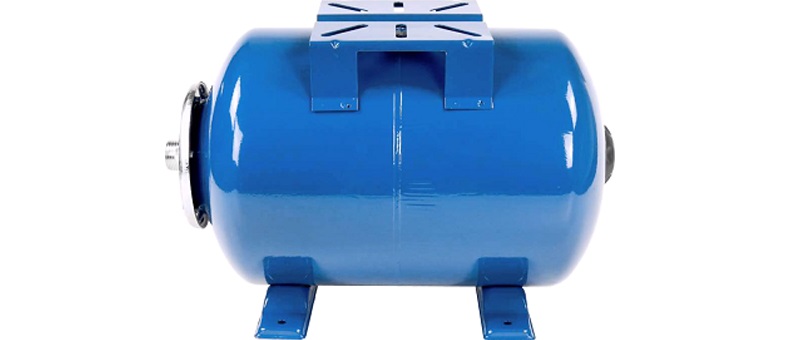
In a private home, a standard battery is installed, which is excellent for functioning in the drinking supply network, which contains a number of specific elements. The hydraulic accumulator tank can be additionally equipped with a pressure gauge, connecting pipes and a valve to allow manual pressure relief.
Among other things, it has a significant difference from the expansion tank. The pressure and temperature levels are completely different, which can affect such performance characteristics as service life, reliability, proper functioning, and product integrity, since in some cases the tank simply ruptures. To be more precise, the elastic membrane can be damaged.
The structure of the hydraulic accumulator and its components
To start the device, it is necessary to immerse the pump (and it can be of a submersible or surface type) in water, while maintaining a specific level of pressure supplied to the elastic membrane tank.
Hydraulic tanks have a certain operating principle, but the design will function correctly if:
- The instructions were used during installation;
- Everything is carefully sealed;
- The product fully complies with the GOST standard for its quality.
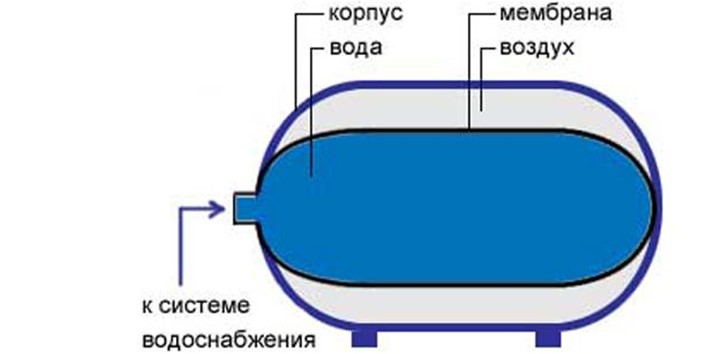
The container expands and the air pressure increases, located in the space between the membrane cavity and internal part tank housing. An increase in pressure helps to turn off the relay, due to which the pump operates, and at this time water flows through the distribution points installed in the house.
Depending on how quickly the liquid flows, it decreases in the membrane cavity.
This means that the air pressure decreases and the relay turns on again for dialing, but this happens at a certain level set by the manufacturer. After switching on, the cycle repeats again until the pump is blocked again.
Hydraulic accumulator tank for cold water supply: classification
A device for controlling the supply of cold water, the operation of which is considered quite simple, may differ according to some criteria, so when purchasing, you need to pay attention to a number of features.
The container volume can be (l):
- even at 400.
A large tank is needed exclusively for industry, and in living conditions it is quite rare to find him. The equipment may vary, depending on the type of installation, in particular, horizontal or vertical. There are no particular differences or advantages between them, since both options are compact in size, but there is a difference in the complexity of the installation process and nothing more.
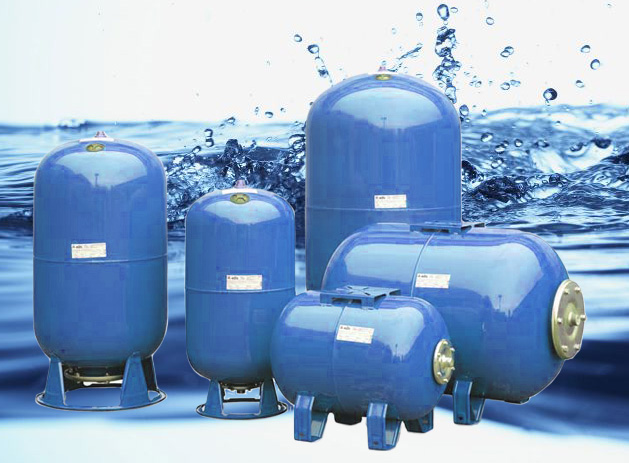
The body material may differ, since there are tanks made of of stainless steel, however, their cost is much higher than cheaper models made from the most common steel sheet and coated with enamel.
The tanks differ in the way the air is released by periodically monitoring the pressure in the cavity of the device body. To do this, a regular-type valve or a banal faucet can be installed. The latter option is most often installed in a hydraulic accumulator designed for a large amount of water. If you want to install a pressure pump, you must approach the selection process as carefully as possible, since the device must be certified and have the necessary documentation for compliance with the GOST standard.
Optimal pressure in the hydraulic accumulator for 100 and 200 liters
It is worth noting that the air pressure in the hydraulic accumulator will affect how well it works, however, before installing a hydraulic pneumatic tank for the water supply, it is advisable to select the device according to its standard size and other nuances.
When selecting, you need to take into account a number of features:
- How much water is consumed per day, as this will affect the capabilities of the pump for supplying water, and the selection of each part must be carried out at the same time, to eliminate discrepancies in connectors.
- What pressure will the energy accumulator maintain in the water supply network? This will be affected by the power of the equipment, as well as how durable the case is. For example, cheap pressure stations do not exceed a pressure of 2 atm, which in some cases can lead to malfunction.
- The size also depends on whether the pump is submersible or surface pump. For example, with the submersible option, you need to locate the hydraulic pump at the outlet, which will prevent additional and unauthorized switching on and off. If the pump is of a surface type, then the installation of the hydraulic accumulator should be carried out in close proximity to it. The higher it is located, the smaller the design can be chosen in terms of volume. A surface pump is installed on a much smaller tank than for a submersible one.
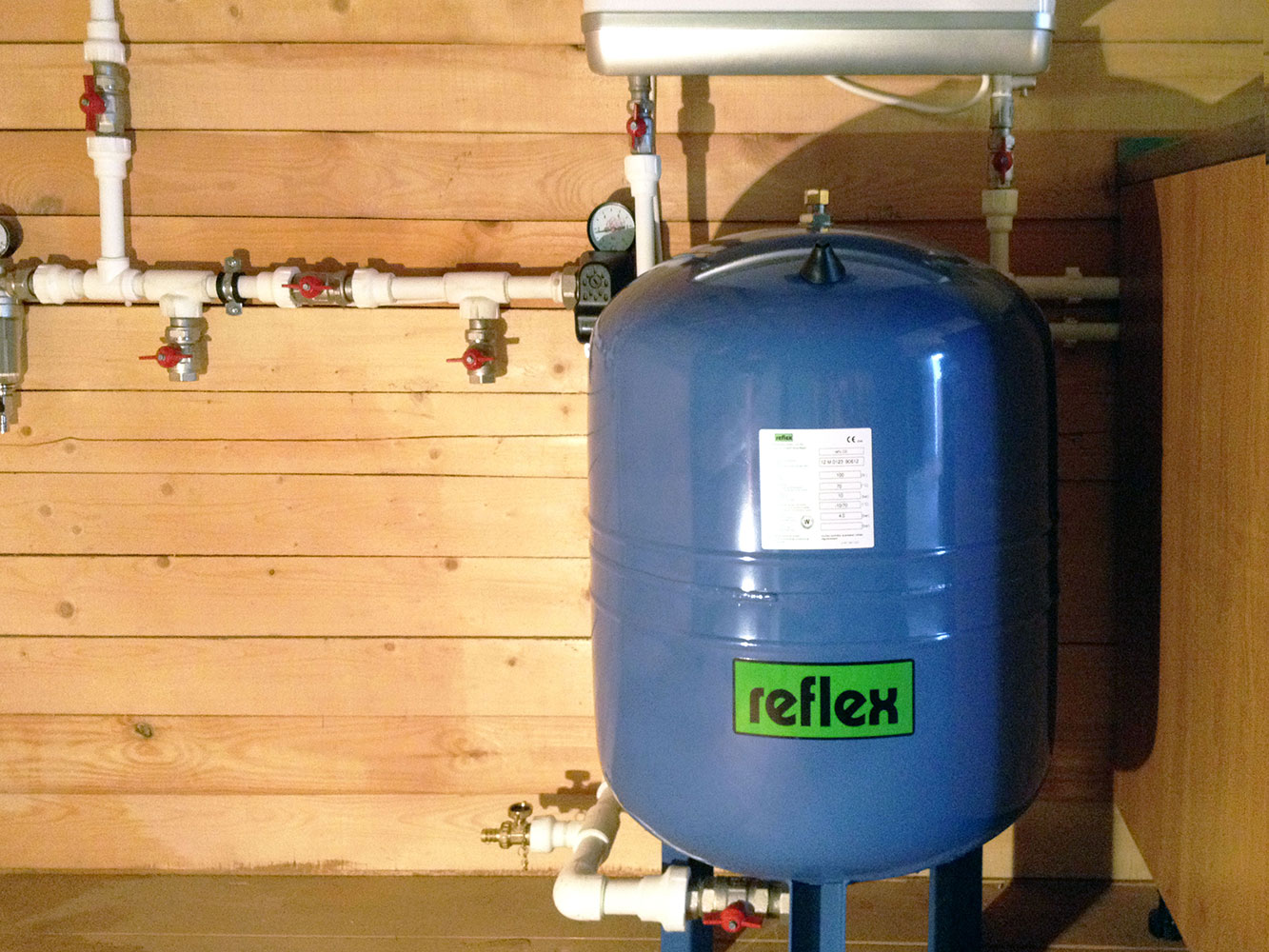
Whether present or absent check valve in the cavity of the water supply system inside the house, the pressure also depends. For example, in the absence of such a valve, the hydraulic tank is mounted in front of the place where the tee is installed in the water supply circuit, and the installation of a pressure gauge is required. By technical safety It is permissible to turn the pump on and off no more than 25 times per hour, which will prevent breakdowns and repairs.
The principle of operation of a hydraulic accumulator in a water supply system and its capacity
When equipping the water supply system with automation, you need to first check it for leaks and malfunctions, and if there are any, then determine the reasons for their occurrence, which will allow for more competent maintenance. It is worth noting that some people prefer to install a homemade hydropneumatic receiver.
However, when assembling it with your own hands, you need:
- Strict adherence to technology;
- Compliance with recommendations from specialists;
- Use only high-quality materials.
In this case, you should not pay attention to such points as, for example, what color the tank is, blue or red. After collection you need to carry out full review design to identify problems, which directly determines its validity period. As for the capacity of the tank in the accumulator, this directly depends on how many points water is supplied to in the house.
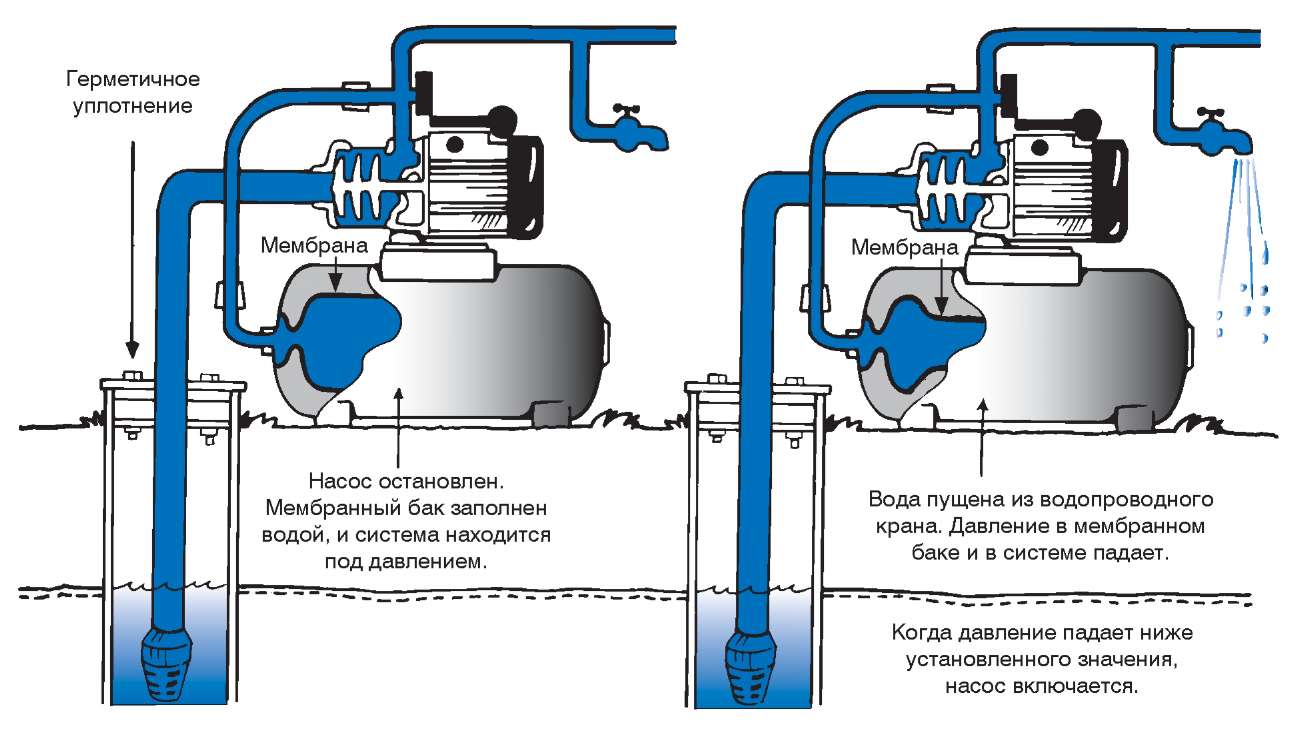
For example, for a family of 2 people, 50 liters is enough, but for 3 or more people – 150 or 200 liters.
When choosing tank types based on capacity, you need to immediately decide on the location. During installation vertical view, you need to add a third of the volume to the design pressure value, due to which the pump will turn on much less often. However, it is worth considering the fact that the room where the equipment will be installed must be warm and without sudden temperature changes, which can lead to damage to the device.
Hydraulic accumulator for water: installation
As already noted, hydraulic accumulators are considered not particularly suitable for heating and hot water supply. In addition, it is worth considering that if installed incorrectly, even problems may arise.
Why and what kind of tank has problems:
- It is impossible to drain the water because the drain is clogged;
- After the pump stops, the water goes back to the source;
- The tank doesn't fill up enough;
- The nipple begins to leak;
- The pump does not hold pressure, and it drops sharply rather than gradually;
- Uploading is very slow and the like.
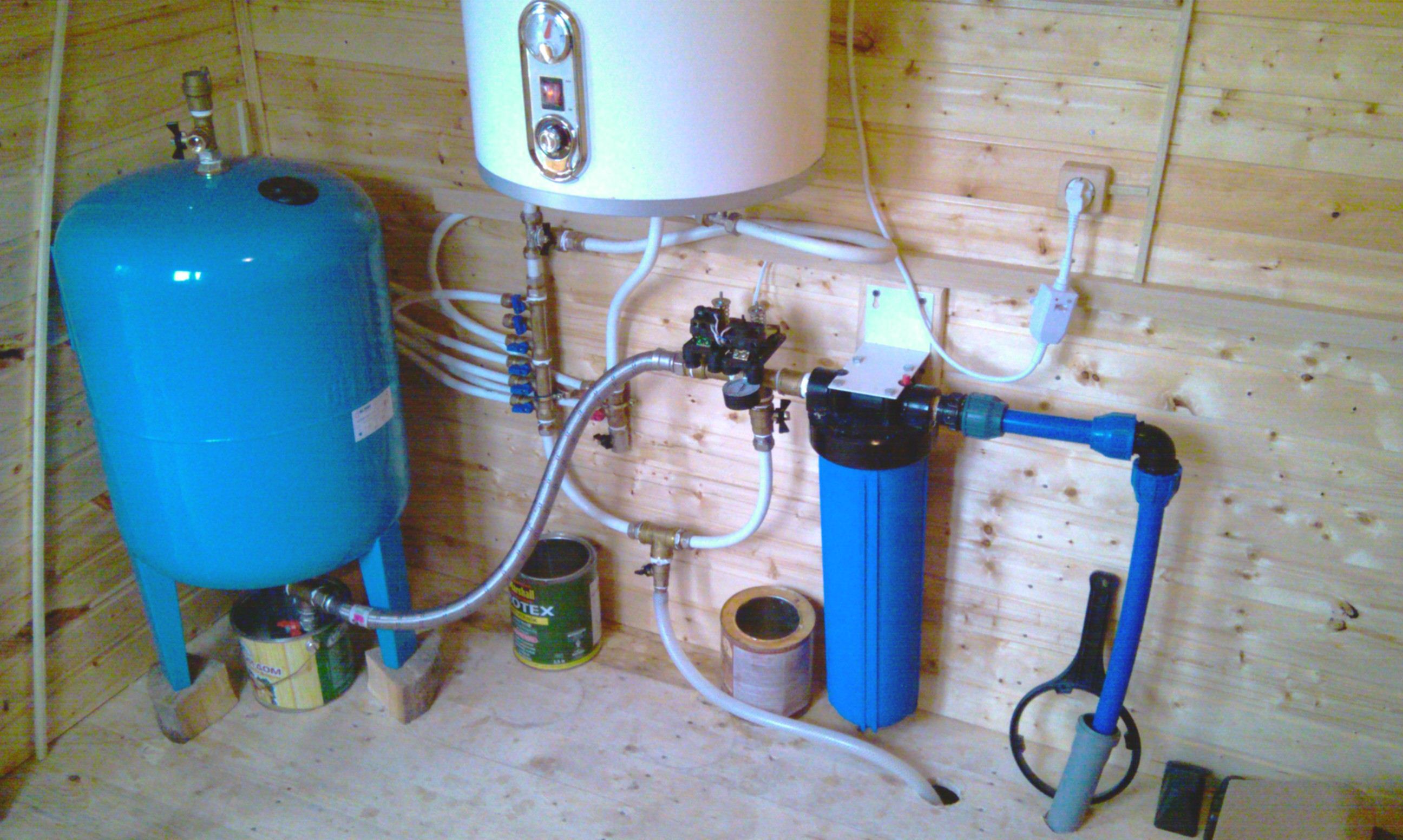
All these malfunctions are associated with illiterate installation. In order to be confident in the serviceability of the entire system after assembly or purchase and subsequent installation, it is worth conducting testing. It is necessary to check the integrity of the structure and connections. Using a car pressure gauge, the pressure inside the container is measured. Connection is made to the outlet in the pump and the hole in the water supply system, with additional installation safety valve.
It is necessary to pump water into the hydraulic accumulator, and then the mandatory setting of the relay follows.
The accumulator tank will be filled with water, gradually, so that the membrane does not rupture. At this point, you need to carefully monitor the data on the pressure gauge and monitor the correct installation and operation of the relay. The pump is turned on and the pressure is monitored, which should decrease by no more than 10% upon start-up. It is advisable to carry out a check for preventive purposes. general condition devices once a month, which will help to find problem areas in the equipment as quickly as possible and eliminate them at the initial stage of failure.
How a hydraulic accumulator works (video)
Experts recommend that when buying a hydraulic tank, pay attention to the popularity rating of the products and not buy too cheap designs. And also hire professional craftsmen for installation, which will eliminate installation problems and provide warranty service.








